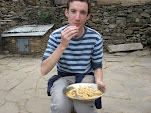
Henna decorated feet
It was great to see Saru again for those few days. Every time I had come to Nepal before, she was always in the house. It does seem a bit quieter without her. So when she is allowed by her husbands family to visit, the house becomes slightly more alive. However for me things get a bit quieter as everyone is talking to Saru, which I don't mind at all. Sometimes though, when everyone is talking a different language and laughing you feel that they're all part of a club which you're not allowed in to. But it's not that I'm not allowed, I just don't understand yet. So, I've been working harder on my Nepali language over the last few weeks, trying to get more fluent. I am managing to understand more, however speaking is still a bit of a problem. The answer to this is practice, I know, and confidence. It's a matter of get confident stupid.
In 2 weeks I'm going to be heading out to see some projects run by some friends and see if they have any bright ideas. I've also been working on a website for someone else, which has been fun, as it's something else to do with my time.
One great thing about Asar, the previous month, and Saun is mangoes. All over the streets are mango sellers, selling mangoes for 30 rupees a kilo - about 25p. Someone also sent 10 kilos from the village, where they're abundant on the trees, so this means by the time I return to the UK, my mango habit is going to be an expensive one. The thing about Nepal is it's like it was in the UK 30 or 40 years ago. Each fruit has its season, and once it's finished for the time you can't get it. Which makes each time of the year special in its own way, and I like this. It makes you appreciate everything a little more. However, I'm going to miss not eating the mangoes.
And on the subject of food everyone has been hearing about the world food crisis in the news, and feeling it a little when shopping, but I thought I'd give you an example of how it's affecting people here in Nepal. The average Nepali wage is a dollar a day - equivalent to about 70 rupees. So over a thirty day month that is 2100 rupees. The house I live in earns about 9000 rupees a month, which is over 4 times the average. (Just as a quick thought - there are quite a few people that earn over the average wage, so conversely there must be a lot of people earning less than a dollar a day.) Even though the house earns well over the average, and for a Nepali family it is not that large at 6 people, almost all the 9000 rupees are spent on food. A 30 kg sack of rice - the Nepali staple and a synonym for food in the Nepali language - costs about 1000 rupees and lasts 20 days maximum. Then there's the vegetables, spices and other items that need to be transported into the valley and so the prices have gone up with the fuel price increase. How people are surviving on 2100 rupees I don't know. There are rumours that many places in the country only eat one time a day. This not only causes hunger but reduces the ability of people to work as they just don't have the energy from lack of nutrition, so they can't grow the food and so further rely on World Food Programme handouts.
So, we'll see how everything goes over the next couple of weeks, and see how far forward things can move in terms of work. Being positive.
SAM


No comments:
Post a Comment